Acoustic Research AR-2a Loudspeakers
Replacement of the Tone Control Potentiometers
History Lesson
Acoustic Research, Inc. (AR) was founded in 1952 and incorporated on August 10, 1954 by
audio pioneer, writer, inventor, researcher and audio-electronics teacher Edgar M. Villchur
(1917 - 2011) and his student, Henry Kloss (1929 - 2002).
Edgar M.
Villchur Obituary
NY Times / October 18, 2011
Edgar Villchur took his new design to two speaker manufacturers but they were not interested.
One of his former students, Henry Kloss (1929 - 2002), was interested. Kloss, who was building Baruch-Lang
loudspeakers for mail-order sale, had invited Villchur to develop his loudspeaker design in his
Cambridge shop. Previously, Villchur believed that creating a commercial product would require
the resources of a major loudspeaker manufacturer. "After these two rebuffs, and in particular,
because of the nature of the rebuffs, I changed my mind", said Villchur. In the spring of 1954,
Villchur drove Kloss up to his lab in Woodstock, NY describing the theory of his new enclosure
design along the way. After they arrived, Villchur played some recordings, including an E. Power
Biggs LP with copious low-frequency content. After hearing it, Kloss exclaimed, "That's it!"
and again offered the use of his Cambridge (Massachusetts) loft to manufacture acoustic suspension
loudspeakers. "And thus, AR was born, observed Villchur." (Birchall 1993). See references, below.
In 1954, Acoustic Research introduced the small AR-1 bookshelf loudspeaker that used the acoustic
suspension principle developed by company co-founders Edgar Villchur and Henry Kloss. These were
soon followed by the AR-2 and the AR-3 with an improved dome tweeter in 1958. A bit later the AR-2a
joined the lineup. The AR-2a added the AR-3 tweeter to the existing AR-2 system. At that time the
company was also producing the AR Turntable, which Villchur designed.
Good Flea Market Hunting
On Sunday, September 17, 2006, I chanced upon an outdoor flea market in New Fairfield, Connecticut
called, "Junk In The Trunk" – where I snagged a nice pair of AR-2a loudspeakers for $2.00 each.
The serial numbers were: D 38044 and D 21571. Officially, they were each labeled, "Acoustic Research Suspension
Loudspeaker System." The wooden cabinets needed a little clean-up and oiling. However; the grille cloth
was in very good condition, and both the "AR" and "a" logo badges were still affixed to the grill on both enclosures. Each enclosure features a 10-inch woofer, two five-inch mid-range cones and a 1.375-inch dome
super tweeter. These vintage speakers do not use foam surrounds on the woofers, as later models do.
The surrounds are instead made of a more durable cloth material.
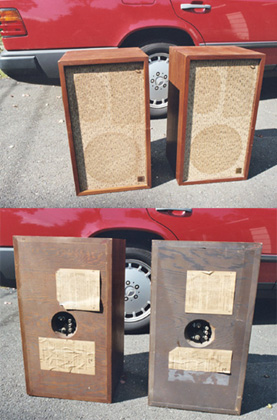
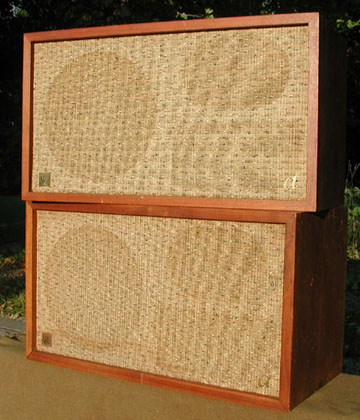
Model "AR-2a" loudspeakers produced from 1960-1969 by
Acoustic Research, Inc.
24 Thorndike Street
Cambridge 41, Massachusetts
Photo (left): "AR-2a" loudspeakers as found in New Fairfield, Connecticut. Camera: Canon AE-1 PROGRAM /
Kodak ASA 200 film). September 17, 2006.
Photo (right): Back home, before replacing the tone control potentiometers.
Camera: Nikon Coolpix 990. September 24, 2006.
The Type AR-2a loudspeakers were made by Acoustic Research from 1960 to 1969 and reviewed in the May,
1960 edition of High Fidelity magazine. For some perspective on price, in 1957, the previous
model, the AR-2 loudspeaker, sold for $87.00 each.
Pig In A Poke?
While testing the speakers, one sounded very nice, while the other's mid-range cones and tweeter were
not working. The potentiometers for the adjustment of the mid-range and high-range settings are located
on the rear of the cabinets, and were suspected as being the cause of the middle and high range tones
not emanating from the one speaker. As specified on the original paper labels on the rear of the
cabinets, there is a "strap" (small jumper wire) that connects terminals "2" and "T" at the back of
the cabinet that enables the mid-range and tweeter cones. For woofer-only operation, the strap can be
removed. The jumper wires ("straps") were in place, so that was not the reason for the problem on the
one unit.
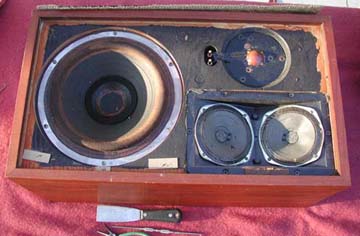
The AR-2a loudspeaker with grille cloth removed.
Disassembly
The front grille frames were removed without damaging the wood or the grille
cloth. The speaker cones themselves are not usually at fault when the mid-range and
high-range cones are not working. The mid-range and high-range tone control potentiometers
get dirty, corroded, and are usually the source of the problem. See references, below.
I was puzzled by how the grille cloth was affixed to the cabinet. Later speakers such
as the "Advent 1" (Advent was another company started by Henry Kloss) use Velcro to affix
the grille cloth and frame to the main enclosure. The key to removing the grille on the
Type AR-2a was to remove all of the small staples (approximately twenty) from the particle
board that go through the grille cloth. This was not intuitively obvious to the casual observer!
The staples are so small that they are almost invisible when the speaker is observed head-on.
Also, they are aligned with the pattern of the grille cloth so they are not
obvious. The staples go through the grille cloth, then the particle board, and finally anchor
in the inner wood sub frame of the speaker body. Once the staples were removed, I used a
machinist's scribe, with an "L" bend at one end, to leverage, and
lift up the center of the particle board. The center of the particle board then bowed
up, and the ends lifted out of the routed grooves that run around the perimeter of the inner
edge of the speaker cabinet. This is difficult to describe. For functional clarity: I was able
to carefully insert the thin metal scribe with the "L" shape at the end through the loose weave
of the grille cloth and lifted up on the center section of the particle board. Note that the
grille cloth is glued to the particle board.
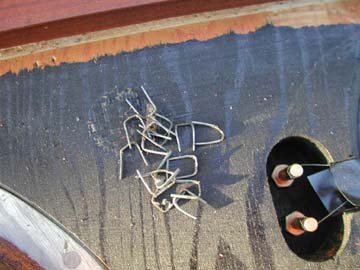
These are the staples that held the particle board (and the grille cloth) in place. They do not
necessarily need to be replaced during re-assembly. Double sided tape or Velcro may be substituted
so the grille frame is easier (but also more likely) to be removed in the future. For
reference, I purchased new staples for my Arrow JT21 staple gun. A suitable
replacement staple size for the AR-2a loudspeakers is 3/8" 10 mm Genuine
JT21 staples. "JT21" is the model of stapler, made by Arrow. These staplers
are ubiquitous, and have been made for many years. Check an art supply, or hardware store.
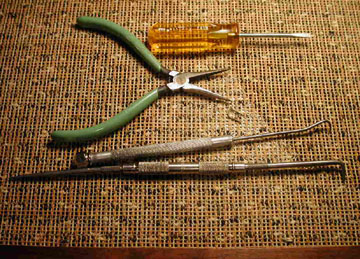
Here are the tools I used to carefully remove the staples from the grill cloth.
A small, flat-blade screw driver, small needle-nose pliers, and scribes of
various shapes (resembling dentist tools). Patience is a virtue in this process
because it would be easy to damage the grill cloth, or puncture your skin.
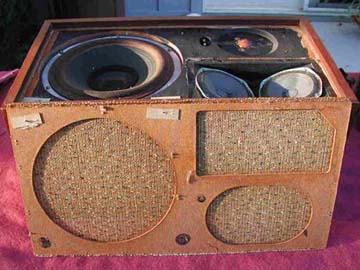
This photograph shows the rear of the particle board (a.k.a. grille frame) with the original
speaker cloth glued to it. I believe that similar grille cloth is available as well as newly
manufactured reproduction particle boards (see references below). One thing I discovered by
opening these cabinets was that they were completely undisturbed from original condition.
To gain access to the potentiometers, it is only necessary to remove the woofer.
This is a job that takes a certain amount of finesse, otherwise the speaker or worse,
your hand, could sustain serious damage. The woofer was a challenge to remove, but by
using a thin screw driver blade to remove some of the old black sealant from around the edge
of the woofer assembly, I was able to get it to move (albeit slightly) in the cut-out
recess of the enclosure before lifting it out. After the old, somewhat pliant, bead of sealant
was removed from the outer edge, I used a wider screw driver to work the woofer assembly free and
break the strong seal that had built up over the years. Once that tension was broken, the screw
driver was used to carefully pry (lift) the woofer out of the cabinet with relative ease. Do not
start the process simply by prying the woofer assembly out of the cabinet because the wood will
be damaged. The damage will not be seen once the grille cloth is back in place, but you will know
about it. Remove the sealant from around the edge first, as detailed in the passage above, and
there will be greater personal satisfaction when the job is done.
Disconnect (unsolder or cut) the two wires (red and blue) that go to the woofer. Make sure they
go back in the same locations! Under the woofer, there will be a cheese cloth type material, which
acts as a protective barrier between the speaker cone and the copious insulation (the old, nasty stuff)
that was placed inside the cabinet during assembly. Only remove the woofer, and as much insulation as
needed, to gain access to the potentiometers. Store the insulation in a large shopping bag while the
project moves forward. You may want to use gloves when handling the insulation.
Before going further, take this opportunity to vacuum out the remaining particles of insulation,
dust, and any other grunge that may have accumulated over time inside the
cabinets.
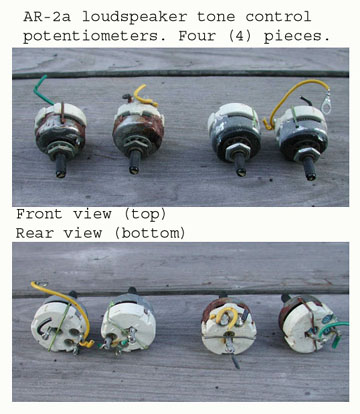
Original tone control potentiometers
New Life for Old Parts
This photo illustrates the condition of the un-restored, original style tone
control potentiometers from the AR-2a loudspeakers. The two on the left (front
view) were removed from the speaker that had no high frequencies coming from
the tweeters. Notice the rust and corrosion on that set. The two on the right
(top view) were in slightly better physical condition, and came from the
cabinet that had a full range of frequencies, but adjusting the pots made no
difference to the tone. I sold them for salvage through an advertisement on
this page on August 30, 2008 for $12. I had literally tossed them into the
workshop trash bin, but couldn't bare to see them go to waste, so plucked
them back out, and placed an advertisement on this page – and waited. It
took about a year before someone bought and restored them. I still marvel at
the power of the internet. The moral is that there is a community of people
who really appreciate this equipment, and your speakers (and associated parts) may be
worth something to someone. I later received a follow-up e-mail from the guy who bought them,
and he said they cleaned up nicely and became functional again.
Replacement Parts
Fortunately, I discovered a good resource for AR loudspeaker parts, including potentiometers,
on eBay. The seller's i.d. was, "vintage-ar." He provided useful information
(via e-mail) on how to remove the grille cloth. His price for the potentiometers
was $9.95 each plus $4.50 shipping for four, a total of $44.30. Shipping for two would
have been $2.50. He is located in Albany, NY. The kit includes instructions with a cross
reference of the old potentiometer pin-out to the new potentiometer pin-out. I also ordered
some black speaker cabinet sealant. It was a good match to the original sealant, but I could have
used a bit more of it. He also included a little extra wire (same colors and gauge as original)
because some of the wiring was tight to begin with. Where I lengthened the wire, I used "window butt
splices" (with translucent, shrink wrap, weather resistant covering) rather than solder them.
However; I soldered the connections at the potentiometers and woofer themselves.
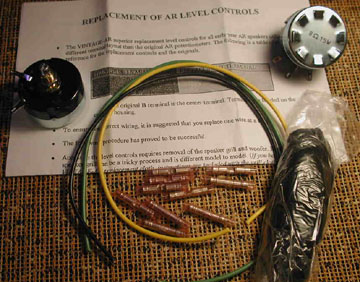
This shows the items in the potentiometer replacement kit, and more. The "window butt splices"
(with pink translucent plastic insulator, shrink wrap covering) were not included in the
kit. Otherwise, the kit consisted of the potentiometers, extra wire (correct gauge and colors)
and the instruction sheet. The black sealant was an extra cost option, and well worth it.
The original sealant was dried out and not capable of being re-used. One unit of replacement
sealant is sufficient for re-sealing one woofer. If the other speakers are going to be removed,
get more sealant than what is shown here.
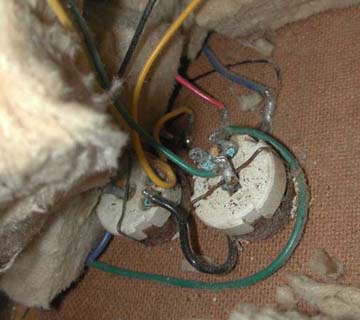
These are the original potentiometers from the inside the cabinet. There is a lot of
insulation packed inside. The other speaker's potentiometers did not look quite
as bad, but they were not operational either.
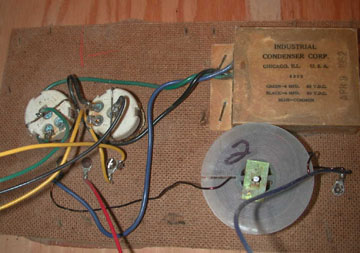
After removing the insulation, and vacuuming the inside of the cabinet, here is a
shot of the original potentiometers. Note the date of "Apr 9 1962" on the crossover unit.
The other speaker's crossover unit was not date stamped.
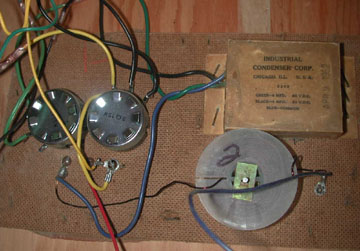
This view shows the new potentiometers (both are marked, "8 Ω / 15W") in place. They
fixed the problem of the tweeters not working on this speaker.
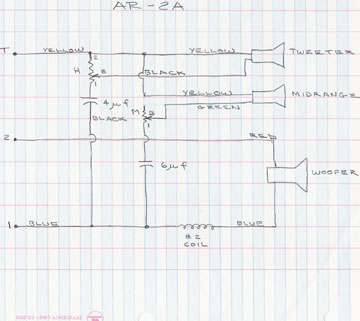
Schematic of the tone control potentiometers and the speakers.
Courtesy: Larry Lagace July 20, 2008.
No Rush
This job can not be rushed because of the risk of damaging: 01) the wood cabinet, 02) the
speakers, 03) the grille cloth, or 04) your self (these are heavy!). Total time (per speaker)
spent on removal of the grille cloth, the woofer, replacement of the potentiometers, and
putting everything back together was about four hours. This included rubbing the cabinet
with a slurry of paraffin oil and rottenstone.
The Final Step in the Process
The final step in the process took me about 29 years to
complete. How is that possible? In 1977, I considered purchasing a Harman/Kardon "330c" AM/FM
stereo receiver. But by the time I saved enough money, H/K had
dropped the model 330c from their program. It was only made from 1976-1977. So, in 1978 I got
the newer H/K model "HK 340" receiver instead. The HK 340 was technically almost the same receiver
as the model 330c, but had a more "sterile" appearance, which was probably a sign of the changing
styles in audio equipment at the time. I always regretted not being able to get the more attractive
HK 330c.
Anyway, after the AR-2a speakers were finished being restored, they looked
kind of lonely sitting on the bench all by themselves. So I watched the online auction site,
eBay, for an HK 330c in good condition. I discovered that they were relatively common, and
selling for surprisingly low prices. I took the plunge, and set my high bid at $17.00 on a decent
looking one, but another bidder won the auction for $17.50! On Friday, October 13, 2006, I ended
up "buying" one directly on eBay for $49 (with their "Buy It Now" feature) plus $25 shipping for
a grand total of $74.
According to the AR
Loudspeaker Manual 1 the AR-2a loudspeakers and the
Harman/Kardon 330c receiver are a good technical match because the HK 330c amplifier was rated
at 20 watts RMS per channel output. Harman/Kardon was typically conservative on their ratings,
so the 330c is probably putting out something closer to 25 RMS watts per channel.
The AR-2a loudspeakers require a minimum of 20 watts input to drive them, and can handle "over
100 watts" input. Although somewhat counter-intuitive, the biggest potential danger of using the
HK 330c with the AR-2a loudspeakers is not from being over driven, but by being under driven. If the
amplifier goes into clipping, the tweeters burn out very easily (due to harmonics). Search the internet
for "audio clipping" or "amplifier clipping" for a more technical explanation. Anyway, this
combination sounded quite good to me, and the AR-2a loudspeakers were not likely to be under (or
over) driven by the HK 330c. On the afternoon of Saturday October 21, 2006 I listened to Beethoven's
7th symphony (courtesy: WXXI 91.5 FM) and was transported into another world by this retro
high fidelity (HI-FI) equipment and the incredibly emotional music.
I predict that at some point in the near future, people will get tired of listening to their
highly compressed music on iPods, and re-discover the joys of a room-filling audio system
such as this.
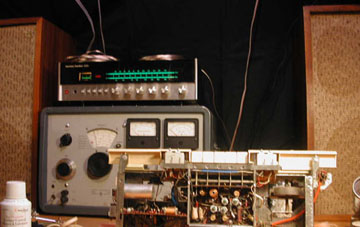
This photo shows the restored "AR-2a" loudspeakers (circa 1962)
married to a Harman/Kardon "HK 330c" AM/FM stereo receiver (1976-1977). The
HK 330c has coils of speaker wire on top, and is sitting on a Hewlett-Packard "606a" RF signal
generator (US Army surplus / circa 1966). Finally, the radio chassis on the workbench is from a
Grundig "2066 PX" AM/FM/SW tube radio (circa 1958). The photo was taken October 20, 2006.
The HK 330c has a clean, uncluttered design, which features a black tuning dial
with green illuminated numbering. It also features a red "stereo" indicator light, an analog
signal strength meter, and a nice, illuminated, red power button (all receivers should have an
illuminated power button). The cabinet surround is black metal and is held in place with two
screws on each side and two smaller screws at the top. It will play two sets of speakers simultaneously,
and puts out 20 watts per channel. The
HK 330c Owner's Manual 1 was available in .pdf
form from the Harman/Kardon website. A copy of the
HK
330c Technical Manual 1 was provided by a visitor to this
web page in July 2008.
Upon its much-anticipated arrival - October 19, 2006 - the HK 330c was missing two screws. One at the
back, for the 300 Ω FM antenna connection, and one on the top of the cabinet. I was able to source
both screws at "Service Technology" (Winton Road shop near Jefferson Road) from a donor 330c. Other than
that, the push-button function switches were a bit stiff. Once depressed, they would not release. So I
opened up the cabinet and sprayed them with contact cleaner & lubricant. This did a good job freeing
them up. Overall, it arrived in good cosmetic condition, and did not require much in the way of a
cleaning. Only the nooks and crannies needed to be detailed.
Total cost for this retro stereo system came to $129.95. Itemized, that breaks
out to: $4.00 for the pair of AR-2a loudspeakers (quite possibly the best deal
of the 21st century), $51.95 for the speaker repair parts, and $74.00 for the
HK 330c receiver. Not including the eight hours of labor on the speakers and
the 29 year wait to get the Harman/Kardon 330c.
| Correspondence from another AR-2a
Owner |
Hi,
I read your story about restoring your AR-2a
loudspeakers today.
I found it quite interesting and enlightening. I have an identical pair
that my dad bought new in 1963. He and mom used them in the family home
for years. After that, my sister and I took turns using them. They were
kicked around the country from Wisconsin to California and back to
Wisconsin. I now have them permanently in New Mexico. I haven't really
used them for years, but during the time I was using them I drove them
with ...wait for it... a H/K 330c! It was the second such receiver I had
owned. I left one in San Francisco in '76 along with a pair of Advent
speakers when I moved back to WI. Shortly thereafter, I bought the newer
330c to replace the one I had left. I really loved the old H/K gear. That
330c served me well for many years. The ARs, for the last 25 years or
so, have been utilized as speaker stands for various other speakers.
Most recently, a pair of Bose 201s. Sort of a sad commentary, I guess.
The old ARs are scratched and dented, and the grill cloth isn't new
anymore. There are a few tears. One of the front badges is missing, and
the finish is a sight to behold. Dad bought them unfinished and then
finished them himself. Let's just say that he was NOT a pro furniture
refinisher! I think about selling the ARs now and then. Today, I'm
thinking about selling them. They would be better off with a lover of
old gear than they are with me. So, that's about all I have to offer.
Just thought I'd drop you a line. Take care and enjoy your vintage
equipment!
Kind regards,
Jon Swalby
New Mexico
April 5, 2014
|
References
AR-2a Loudspeakers
- AR Loudspeaker
Manual (circa 11/1973)
- www.classicspeakerpages.net
-
www.stevehoffman.tv/forums/archive/index.php/t-44045.html
- The Speaker Place (no longer in business)
/ Henrietta, NY / 585-424-3680 / had potentiometers for $15-$20 each.
- Larry Lagace / Ljlagace ]at[ aol.com / Albany, NY / 518-869-3665 / eBay i.d.: "vintage-ar" / Potentiometers for AR speaker tone control: $9.95
each plus $4.50 (shipping for all four). Specializes in AR speaker parts. Helpful e-mail support. Placed
the order for four potentiometers and black cabinet sealant on 27-sep-2006. He posted the package on the same day.
Arrived: 29-sep-2006. The sealant was an extra $2.95 for one bag. One bag of sealant is enough for one
woofer. I ordered two bags (to do both speakers). The extra shipping for the two bags of sealant was $1.75.
Grand total for parts and shipping to restore these speakers was $51.95.
- Larry Lagace's AR eBay store:
VINTAGE-AR PARTS AND SERVICE
Harman/Kardon 330c

c o n t a c t / r a d i o w o r l d
Acoustic Research AR-2a Loudspeakers
Established: September 26, 2006
Links Verified
September 06, 2024
Last Update:
September 09, 2024
© Black Sparrow Photography / Jeffrey P. Miller (N2AWA)













